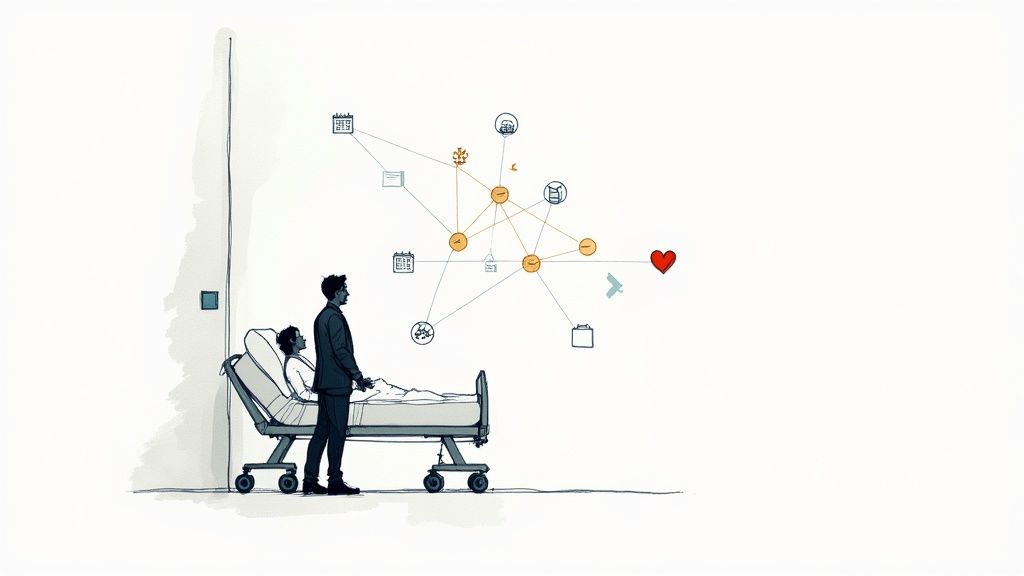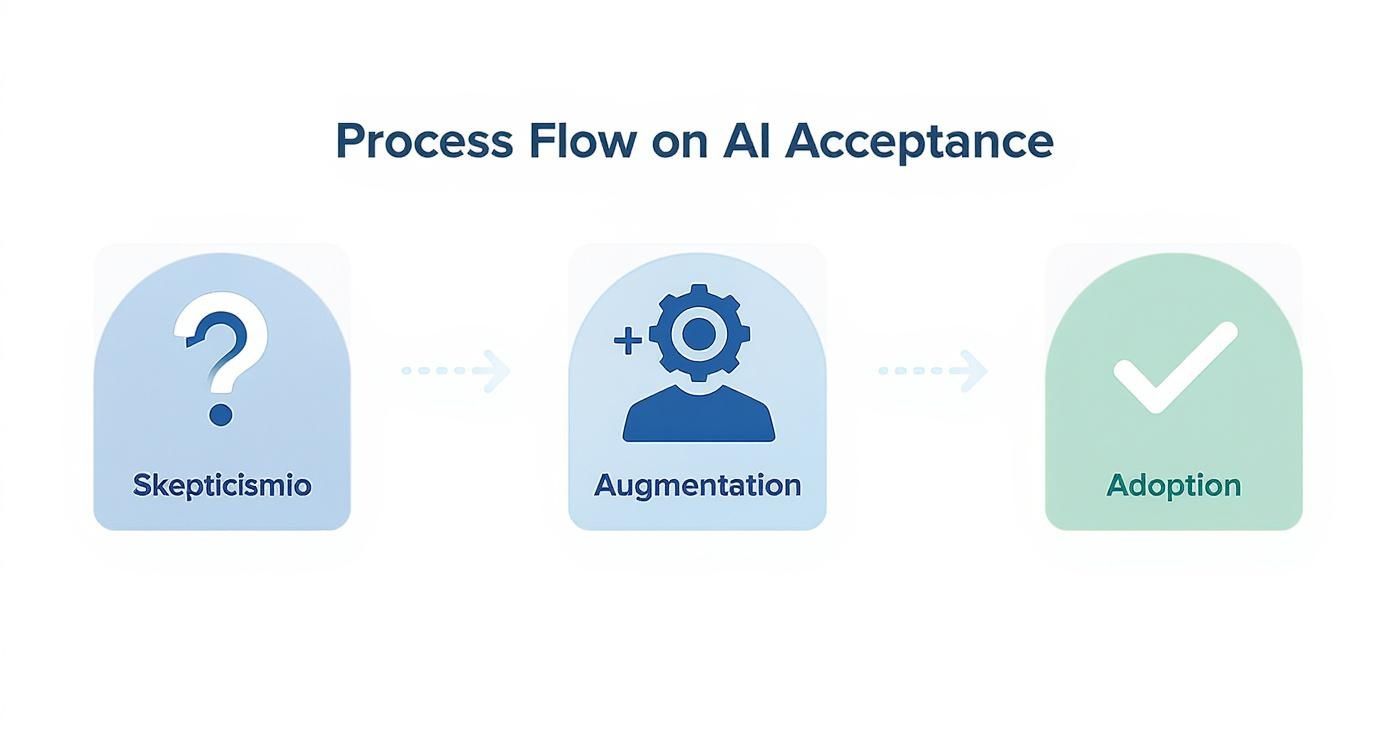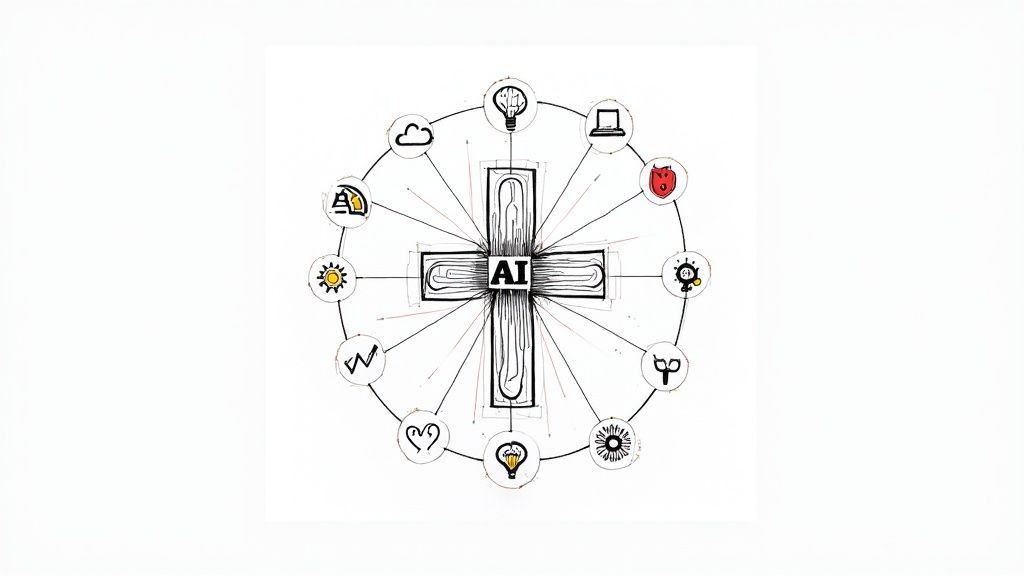A Guide to AI for Medical Innovation
Explore our guide on AI for medical applications. Learn about benefits, real-world examples, and implementation strategies for healthcare leaders.

Picture a hospital where the mountain of administrative work starts to shrink. Where diagnostic tools become sharper, and patient care gets more personal, even proactive. This isn’t some far-off sci-fi fantasy; it’s the reality being built right now with AI solutions. For any leader in the medical field, getting a handle on this shift isn't just an option—it's essential for staying competitive and delivering top-tier care.
The New Reality of AI in Medical Care
Artificial intelligence is no longer just an experiment in a lab; it's becoming a fundamental part of how medicine is practiced. Hospitals and clinics are stretched thin, dealing with everything from staff burnout and logistical jams to the relentless demand for quicker, more precise diagnoses. AI designed for medical settings tackles these problems head-on, acting as a powerful co-pilot that improves both clinical results and operational flow.
Think of this technology as a practical, powerful tool for today’s healthcare hurdles. By taking over routine tasks and making sense of massive, complex datasets, AI gives medical professionals back their most valuable resource: time. Time to focus on what they do best—connecting with patients and making critical, human-centered decisions. This growing adoption isn't just a trend; it's a clear signal that its value in building smarter, more resilient healthcare systems is undeniable.

Why This Is a Strategic Imperative
For healthcare executives, folding these technologies into the big-picture plan is now a non-negotiable. The pace of adoption is picking up fast. In the United States, an incredible 46% of healthcare organizations are already getting their feet wet with generative AI. That's a huge shift, signaling a real commitment to advanced technologies that can reshape everything from how a patient is checked in to how clinical policies are formed.
This rapid movement is fueled by real, measurable results. Organizations that embrace AI are simply better equipped to handle the crush of rising patient volumes while delivering a higher standard of care. The trick is starting with a clear roadmap, which is exactly where AI strategy consulting proves its worth.
AI isn't here to replace doctors. It's here to amplify their expertise. The technology is like having a second set of tireless, data-driven eyes that can spot patterns and tiny anomalies a human might overlook, ultimately giving patients a better chance at a good outcome.
Core Areas Where AI Is Making a Difference
AI's impact is being felt most strongly in a few critical areas that form the backbone of modern medicine. Understanding these domains is key to seeing where your biggest opportunities lie.
To give you a clearer picture, here’s a quick breakdown of how AI is being applied across different medical fields.
Key AI Applications Transforming Medical Fields
| Application Area | AI Function | Primary Benefit |
|---|---|---|
| Medical Imaging | Analyzes X-rays, MRIs, and CT scans to detect abnormalities. | Early and more accurate disease detection (e.g., cancer, stroke). |
| Personalized Medicine | Processes genomic and patient data to predict treatment responses. | Tailored treatment plans with higher efficacy and fewer side effects. |
| Operational Efficiency | Automates scheduling, billing, and resource allocation. | Reduced administrative overhead and optimized hospital workflows. |
| Drug Discovery | Simulates molecular interactions and identifies promising compounds. | Drastically accelerated R&D timelines for new pharmaceuticals. |
| Predictive Analytics | Forecasts disease outbreaks and identifies at-risk patient populations. | Proactive public health interventions and preventative care. |
These applications show just how versatile and powerful AI can be when pointed at the right problems.
As we'll dig into next, these aren't just ideas on a whiteboard; they are real-world use cases happening in clinics every single day. By focusing on these core functions, organizations can build a solid foundation for a much broader and deeper integration of AI. We’ve seen this strategy work time and again with our partners in the AI for the healthcare industry. The journey begins by recognizing that AI isn't just coming—it's the new standard of care.
How Core AI Applications Reshape Healthcare
To really get a feel for AI's potential in medicine, we need to move past the buzzwords and look at how these tools actually function in a clinical setting. At its heart, AI is about spotting meaningful patterns in massive datasets—far more information than any human could ever sift through—and translating those patterns into useful insights. This ability is already making a huge difference in three core areas: diagnostics, treatment planning, and hospital operations.
While each application has a specific job, they all share one common goal: to support and enhance human expertise, not to replace it.

This is a critical point for any leader exploring AI solutions. Think of the technology as a highly advanced assistant. It does the heavy lifting on data analysis, freeing up clinicians to focus on what they do best: patient care and making tough judgment calls.
Sharpening Diagnostics with Digital Precision
One of the most established and impactful uses of AI in medicine is in diagnostics, especially in medical imaging. It’s helpful to think of an AI algorithm as a second set of eyes for a radiologist—eyes that have been trained on millions of scans to catch tiny anomalies that the human eye might miss.
For instance, when looking at an X-ray or MRI, an AI model can flag suspicious areas with incredible accuracy. It’s not just guessing; it's comparing the scan against a vast library of both healthy and abnormal images to find subtle patterns that could point to the early stages of cancer or a neurological disorder. The radiologist is still in control, but the AI helps prioritize their focus, allowing them to confirm findings and deliver a diagnosis faster and with more confidence. This kind of collaborative workflow is at the core of many successful custom healthcare software development projects.
Ultimately, this process slashes the risk of human error and shortens the diagnostic timeline—something that can make all the difference for a patient's outcome.
Crafting Personalized Treatment Pathways
The old "one-size-fits-all" approach to medicine is fading fast. AI is the engine powering the shift toward truly personalized care. By analyzing a patient's unique genetic code, lifestyle, and medical history, AI algorithms can start to predict how they might respond to different treatments. It’s a move away from trial-and-error and toward a strategy backed by data.
Imagine a patient with a complex disease. An AI system can analyze their genomic data, cross-reference it with clinical trial results from thousands of similar cases, and then suggest the drug combination most likely to succeed. This kind of deep, personalized analysis simply wasn't possible at scale before. Our AI Product Development Workflow is designed to help organizations build these sophisticated tools in a way that is both effective and secure.
The real power of AI in treatment is its ability to see the individual within the population. It helps clinicians answer the critical question: "What is the best possible path for this specific patient?"
This tailored method not only boosts the chances of a good outcome but also helps patients avoid ineffective treatments and their nasty side effects.
Streamlining Operations for Better Patient Care
AI’s impact isn’t just confined to the exam room; it’s also cleaning up the administrative side of healthcare. Hospitals are incredibly complex environments, often weighed down by the logistics of scheduling, billing, and managing records. These tasks are essential, but they drain time and energy that clinicians could be spending with patients.
This is where automation makes a real difference. AI-powered internal tooling can take over appointment scheduling, optimize the use of operating rooms, and automate the tedious process of insurance claims. Among the various AI tools making a difference, understanding what conversational AI is and how it works is key, as it’s the technology behind many patient-facing tools and back-office efficiencies, like chatbots that can answer common questions or manage prescription refills.
By offloading these administrative burdens, AI directly helps reduce staff burnout and frees up valuable resources. For organizations that want these benefits without building a system from scratch, our AI Automation as a Service offers a direct path to a more efficient operation. It lets your team get back to what they’re really there for: delivering outstanding patient care.
Navigating the Hurdles of AI Implementation
Adopting AI in a medical setting is a huge step forward, but let's be realistic—it comes with its own unique set of challenges. The key is to see these not as roadblocks, but as known variables you can plan for. A successful AI strategy is built on a clear-eyed view of what could go wrong.
This isn't just about the tech. We're talking about safeguarding sensitive data, grappling with ethical questions, and smoothly integrating these new tools with your existing teams. Each piece of this puzzle needs careful thought and proactive management to get it right.
Keeping Patient Data Private and Secure
In healthcare, patient data is everything. When you bring AI into the mix, protecting that data isn't just a good idea; it's a legal and ethical imperative. Regulations like the Health Insurance Portability and Accountability Act (HIPAA) lay down strict rules, and any AI system you use has to be built from the ground up to comply with them.
This means rock-solid encryption, tightly controlled access, and detailed audit trails that show exactly who is looking at what, and when. A data breach is more than a technical problem—it's a catastrophic breakdown of patient trust that can damage your reputation for years. Building a secure foundation isn't optional; it's day one, non-negotiable work.
Tackling Algorithmic Bias Head-On
An AI model is a reflection of the data it learns from. If that data is skewed or doesn't represent your actual patient population, the AI will learn and even amplify those same biases. This is one of the most critical risks in medical AI.
Think about it: if a diagnostic tool is trained mostly on data from one demographic, it might fail spectacularly when used on patients from different backgrounds. The result? Glaring health disparities and profoundly unfair care.
A biased algorithm doesn't just make a technical mistake; it can make an unethical one. Proactively addressing bias is essential for building AI systems that serve all patients fairly and effectively.
To get ahead of this, you have to be deliberate:
- Audit Your Data: Regularly comb through your training datasets. Make sure they truly reflect the diverse community you serve.
- Use Fairness Metrics: Don't just measure overall accuracy. Implement specific metrics to track how the model performs across different demographic groups.
- Monitor Continuously: AI isn't "set it and forget it." Once a tool is live, you have to keep a close eye on its performance to catch and fix any biases that creep in over time.
Integrating AI with Your Medical Teams
The human element is just as critical as the code. If you just drop new AI tools into a clinical setting, you'll likely be met with skepticism, or even fear. Your medical professionals need to see AI for what it is: a powerful assistant, not a replacement. It's a tool that can augment their expertise and free them up to focus on what matters most—the patient.
Finding the right people to build and manage these systems can be a major hurdle. Many organizations find success by leveraging staff augmentation for AI talent to fill specialized roles and bridge internal skill gaps.
A smooth rollout depends entirely on a smart change management strategy. This means robust training programs that go beyond "click here, type that." Explain the why. Show your clinicians how this new tool will cut down on their paperwork or give them a second opinion on a complex diagnosis in seconds. When they see the tangible benefits, you'll get the buy-in you need. Following a well-defined AI implementation plan is the key to managing these moving parts and deploying AI in a way that builds trust with both your staff and your patients from the very beginning. For more information, please visit our page about our implementation support.
Winning Over Your Medical Professionals
Technology is only as good as the people who use it. For any AI initiative to really stick in a medical setting, it has to earn the trust of the doctors, nurses, and specialists on the front lines. The good news is, we're seeing the conversation shift. Clinicians are moving past skepticism and starting to see these tools for what they are: powerful assistants that enhance their expertise, not replace it.
This shift happens when you can show, not just tell, how AI fits into their daily work and makes their lives easier. The best AI tools don't add another complicated step. Instead, they simplify tedious tasks and bring the most important information to the surface, right when it's needed. Think of it as a data-driven partner that helps clinicians make smarter decisions, whether they're tackling a tricky diagnosis, predicting a patient's risk, or fine-tuning a treatment plan.
From Skepticism to Strategic Partnership
That initial hesitation from medical professionals is completely understandable. Their work is built on a foundation of intense training, hard-won experience, and the subtle art of clinical judgment. So, how do you win them over? You position AI as a collaborator that handles the heavy data crunching, which frees them up to focus on what matters most—caring for patients.
For instance, an AI can scan thousands of pathology slides and flag suspicious areas in the time it takes a pathologist to review just one. This doesn't make the pathologist obsolete; it makes them more effective by pointing their expert eye exactly where it's needed. This kind of teamwork builds confidence and makes it clear that AI is a supportive partner, not a replacement.
And the data backs this up. A 2025 American Medical Association survey found that 66% of physicians are now using AI in some form, a huge leap from just 38% in 2023. What's more, 68% of those doctors feel AI is making a positive difference in patient care. This isn't just a fad; it's a clear trend. You can dive deeper into these numbers in the full report on AI in healthcare.
Addressing Valid Concerns with Transparency
Even with all the enthusiasm, there are still real concerns about potential errors and the irreplaceable value of human judgment. As a leader, you have to meet these concerns head-on. The key is transparency. Your clinicians need to understand how the AI came to its conclusions—what data it looked at, and just as importantly, what its limitations are.
AI should never be a "black box" in a clinical setting. The goal is to provide explainable insights that support, not dictate, a doctor's final decision. The ultimate responsibility for patient care always rests with the human expert.
By creating a culture of open dialogue and listening to feedback, you show your medical staff that this isn't just technology being forced on them. It’s a collaborative effort. A great example of this in action involves tools designed to improve how people and systems interact. For instance, our HCP Engagement Co-Pilot helps bridge the gap between healthcare professionals and the technology they use, making sure the tools actually serve their needs.
This approach ensures AI is seen not just as a new piece of software, but as a valued and trusted member of the clinical team. When you empower your medical professionals, you elevate their ability to care for patients. And when they see firsthand how AI sharpens their skills and improves lives, they’ll become its strongest champions.
Your Strategic Roadmap for AI Adoption
So, how do you get from simply talking about AI to actually using it? It’s not about buying the flashiest software off the shelf. For healthcare leaders, a successful move into medical AI demands a clear, deliberate plan that turns a good idea into a practical reality. It all starts with a smart, focused strategy that manages risk while going after the biggest impact.
The best way to begin is by pinpointing a high-value opportunity—a single, pressing problem that AI can solve. This pilot-and-scale approach is absolutely essential. Forget about trying to overhaul everything at once. Instead, pick one well-defined project that can deliver measurable results, and do it quickly. This builds momentum and proves the value of medical AI right from the start.
Most organizations follow a predictable path when bringing in new technology, moving from initial doubt to full integration.

This journey shows how teams naturally progress from questioning a new tool, to using it to augment their own skills, and finally, to making it a standard part of their daily work.
To help structure this journey, think of it in distinct stages. Here’s a simplified breakdown of what that looks like.
AI Adoption Roadmap Key Stages
| Phase | Key Objective | Primary Action Items |
|---|---|---|
| 1. Discovery & Strategy | Identify a high-impact problem AI can solve. | Conduct an AI requirements analysis, define clear KPIs, and secure executive buy-in. |
| 2. Pilot Project | Prove the concept and demonstrate value on a small scale. | Select the right vendor or assemble an internal team, develop a proof-of-concept, and gather initial data. |
| 3. Governance & Integration | Build a secure foundation for data and integrate the AI tool into existing workflows. | Establish data governance policies, ensure HIPAA compliance, and train staff on the new system. |
| 4. Scale & Optimize | Expand the AI solution across the organization and continuously improve its performance. | Roll out the solution to other departments, monitor KPIs, and gather user feedback for future enhancements. |
Each phase builds on the last, creating a solid foundation that ensures your AI initiatives are both effective and sustainable.
Identifying Your Starting Point
First things first: find the right problem to solve. Don't get distracted by the latest AI trends. Instead, look inward at your organization’s biggest headaches. Are diagnostic backlogs piling up? Is your administrative team swamped with manual tasks? Are patient readmission rates too high?
Focus on challenges where the return on investment is undeniable. As we explored in our AI adoption guide, picking the right pilot project is probably the single most important decision you'll make. Once you’ve zeroed in on an area, you can explore the different AI tools for business available or even think about a custom build.
Assembling the Right Expertise
With a use case locked in, you need to decide who will bring it to life. You have two main options: build an in-house team or partner with outside specialists. An internal team gives you more control in the long run, but it’s a major investment in hiring, training, and resources.
Bringing in external experts can seriously speed up your timeline and inject specialized knowledge right where you need it. This is where our expert team often steps in to help organizations navigate the technical hurdles of AI development. Whether you build or buy, having the right people on board is completely non-negotiable.
Establishing Robust Data Governance
AI runs on data, and in medicine, that data is sensitive and highly regulated. Before a single line of code is written, you need a rock-solid data governance strategy. This is the framework that guarantees your data is clean, secure, compliant, and actually usable.
Your data strategy is the bedrock of your AI initiative. Without high-quality, secure data, even the most advanced algorithm will fail. This foundation ensures patient privacy and builds trust in the system.
This involves a few key things:
- Data Quality: Creating processes to clean, label, and standardize patient data.
- Security and Compliance: Making sure every step of data handling meets HIPAA and other regulatory standards.
- Accessibility: Building secure pathways for AI models to access the data they need without ever compromising patient privacy.
Getting this right is how you avoid the biases and security nightmares we talked about earlier. A thoughtful data strategy is what sets you up for safe and effective AI adoption.
Defining Success with Clear KPIs
Finally, you can't hit a target you can't see. You absolutely have to define what success looks like from day one by setting clear Key Performance Indicators (KPIs). These metrics should capture more than just the financial impact.
Think about a mix of operational and clinical wins:
- Operational ROI: Less time spent on administrative tasks, shorter patient wait times, or better use of hospital beds and equipment.
- Clinical ROI: Higher diagnostic accuracy rates, fewer patient readmissions, or measurably better outcomes for certain conditions.
By tracking these KPIs, you can build a powerful case for your AI initiatives and show real, tangible value to stakeholders. A Custom AI Strategy report is an excellent tool for this, helping you map your goals to measurable outcomes and paving the way for a successful, scalable AI program.
Measuring the Full Impact of Medical AI
For any executive, it always comes down to the bottom line. When we talk about AI in medicine, the return on investment isn’t just about dollars and cents—it’s measured in both saved costs and saved lives. Grasping this dual impact is the key to understanding just how powerful strategic AI adoption can be.
On one side of the coin, you have the direct economic wins. AI-powered automation is brilliant at tackling the operational inefficiencies that silently bleed budgets. Think about the time spent on routine administrative work like billing, scheduling, and data entry. Automating these tasks immediately cuts overhead and, just as importantly, frees up your staff to focus on the work that actually requires their expertise. In an era of persistent staff shortages and burnout, that’s not just a nice-to-have; it's a strategic necessity for building a more resilient and financially sound organization.
Clinical Returns and Long-Term Value
But the other side of that coin is where things get truly compelling: the clinical ROI. When an AI tool helps a radiologist or a clinician spot a disease earlier and with greater accuracy, the benefits create a powerful ripple effect. An earlier diagnosis almost always means a less invasive, more effective, and far less expensive treatment path.
Think about it this way: a patient whose cancer is caught at stage one has a much better prognosis and a significantly lower long-term cost of care than someone diagnosed at stage three. That isn’t just better medicine; it’s smarter economics.
This direct link between better patient outcomes and long-term financial health is the core value proposition of medical AI. It helps shift the entire care model from being reactive to proactive, which improves lives while bending the cost curve in the right direction. As we covered in our AI adoption guide, this is the kind of strategic investment that defines sustainable growth and gives you a real competitive edge.
Market Growth as a Signal of Proven Value
If you need any more proof, just look at the market. The explosive growth in healthcare AI is a clear signal that the value is real and the results are proven. The global market is on track to blow past $120 billion by 2028, a surge fueled by the urgent need to manage rising patient volumes and combat clinician burnout.
In fact, it's estimated that by 2025, 86% of healthcare organizations will already be using AI to slash administrative work and improve disease detection. This isn't some speculative future tech anymore; it's rapidly becoming a core part of modern healthcare delivery. You can discover more insights about AI in healthcare on blueprism.com to see just how widespread this shift has become.
Ultimately, measuring the true impact of AI requires looking at the whole picture. When you see how operational efficiency and improved clinical outcomes feed into each other, it becomes obvious that investing in medical AI isn't just a tech upgrade. It's a foundational move toward a more effective and sustainable future for healthcare. To learn how we can help your organization quantify these returns, connect with our expert team.
Common Questions About AI in Medicine
When you start looking at the practical side of bringing AI into a clinical setting, a lot of important questions bubble up for healthcare leaders. Let's tackle some of the most common ones I hear, with straightforward answers to help you guide your strategy.
Where’s the Best Place for Our Hospital to Start with AI?
It’s tempting to think big, but the smartest move is to start small. The best first step is always a focused assessment to find one high-impact problem that AI is perfectly suited to solve.
Instead of trying to overhaul everything at once, pick a contained pilot project. Think about something like using an AI tool to give radiologists a "second look" at a specific type of scan, or maybe automating the incredibly time-consuming process of patient appointment reminders.
This approach lets you prove the value quickly, keeps the risk manageable, and teaches you invaluable lessons you can use before you even think about scaling up. Our AI strategy consulting can help you zero in on that perfect first use case that fits your hospital's unique situation.
How Do We Make Sure Our AI Tools Are HIPAA Compliant?
This is a big one, and it's absolutely non-negotiable. Compliance isn’t a single checkbox; it’s a foundational part of your strategy that requires a few layers of protection.
First, you should only partner with vendors who will sign a Business Associate Agreement (BAA) without hesitation and can show you their robust security policies.
Next, it's crucial to use data anonymization and de-identification techniques whenever you're training a new model. And finally, you have to implement strict access controls and detailed audit trails to track every single time data is touched by the AI system. Your legal and compliance teams need to be in the room from day one to build your AI strategy with patient privacy baked in from the start.
Is AI Going to Replace Our Doctors and Nurses?
In a word: no. The real goal of AI in medicine is augmentation, not replacement. AI is a phenomenal analytical tool. It’s brilliant at sifting through mountains of data to spot patterns a human might miss.
But what AI can't do is replicate the empathy, ethical judgment, or nuanced critical thinking of a skilled clinician. The future isn't about machines taking over; it's about a powerful collaboration. AI handles the heavy lifting on the data side, which frees up doctors and nurses to focus on what only they can do—providing hands-on patient care, making complex treatment decisions, and building that all-important human connection.
This partnership is how we get the best of both worlds: machine precision working alongside human compassion.
What Does the ROI on a Medical AI Project Actually Look Like?
When we talk about ROI for medical AI, we're really looking at it from two different angles.
On the financial side, the return comes from making your operations more efficient, cutting down on administrative waste, and optimizing how you staff your teams. When you streamline workflows with something like our AI Automation as a Service, you start to see those financial benefits pretty quickly.
But the clinical ROI is where things get truly exciting. This is measured in better patient outcomes, detecting diseases earlier, reducing the length of hospital stays, and delivering more personalized treatment plans. A well-designed AI project delivers immense long-term value by improving the quality of care and shoring up the financial health of your organization. A solid implementation, guided by our expert team, makes sure you're maximizing both sides of that ROI coin.
Ready to turn these insights into action? At Ekipa AI, we specialize in helping organizations like yours build a clear and actionable AI roadmap.



